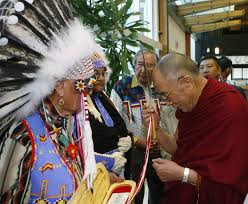Regular contributor Hendon Harris (Chinese Discover America, 2/13/23); Dalai Lama; Marcia Keegan, Tibetans and Native Americans; Dhr. Seven, Xochitl (eds.), March 4th, Wisdom Quarterly
 |
| Meeting Hopi tribal elders in Calgary, Dalai Lama (thegreatgathering.org) |
Were Anasazi Native Americans Buddhists
 |
| Buddhism arrived in America before Columbus |
A: Right. Unless it's all a coincidence.
Q: True, one similarity could be a coincidence, but could all of these?
A: Not likely. There must be an underlying connection.
- [EDITOR'S NOTE: In modern Ladakh/old Tibet, near Hemis Gompa, I saw unbelievable black-and-white photographs of Native Americans or indigenous Mexicans -- with characteristic features of our American Indians: dark skin, Asiatic features, turquoise jewelry, bolo ties, braided black shiny hair, sunbeaten and weathered faces, white cotton clothes, cowboy hats... What were these doing here? How could Natives be known in faraway Asia? These were no Americans but Tibetan cowboys and "Indians" dressed as cowpokes. The similarities were shocking and painfully striking. I had seen the girls at Boudhanath (Eyes of Buddha) Temple in Kathmandu, Nepal, nearly riot around a wandering salesman. I went over on my motorcycle. As the crowd separated and gave way to the bike, to my great disbelief and dismay I saw the cause of the commotion -- Madonna posters, yes, that Desperately Seeking Susan star dressed like a virgin. Any Western token, the Himalayans wanted in! So that they would have been into old Western photographs of cowboys and Injuns would not have been out of the questions. But these were parallel peoples of the Southwest, living in Pueblos like the great Potala Palace and revolving their lives around buffalo, hairy cows and bulls of the plateau and Plains, genetic bison. Above, the 14th Dalai Lama dons a cowboy hat, which looks ridiculous to us, all part of his charming humor, but would not be at all out of place in rural Tibet.]
Tibetans and Native Americans: From the Roof of the World to the Land of Enchantment
 |
| Neutered Kokopelli |
Here is a short list of connections, each of which would require a lifetime of work by anthropologists. Even then, few have made the connection and tied these customs together:
- Tibetan Buddhists and Four Corners Puebloan peoples use masks in religious ceremonies
- Use of phallic symbols (Kokopelli)
- Celebration of the Ghost Dance
- Celebration of the Rain Dance
- Origin and use of mandalas (circles, geometric patterns)
- Origin and use of the ancient swastika (manji)
- [Is the swastika a Native American symbol?]
- [Whirling Log of Native Americans is a swastika]
- [Ancient symbol hijacked by evil - BBC Culture]
 |
| Buddhist missionaries visited America. |
 |
| History of Buddhism in America (Rick Fields) |
While our current worldview has been shaped by the Renaissance in Europe and the Industrial Revolution there and here, the Native American and Tibetan cultures were thriving in a world of isolation from modernity, maintaining their own traditions handed down through their elders.
 |
| Kokopelli is a very phallic figure. |
Tibetan Buddhist (and pre-Buddhist Bon) rituals date back to a root culture called the Shang Shung (Zhangzhung), pre-dating 10,000 years ago. It is the indigenous culture of the Tibetan Plateau in what the Chinese now call China (which amounts to half the landmass of Beijing's conquered empire/occupied territory).
.
Both cultures have co-evolved without any recorded contact between each other until 1979, during the 14th Dalai Lama's first historic visit to North America.
Marcia Keegan was there to arrange the initial meeting between a Hopi elder and the Dalai Lama's delegation.
The Hopi greeting of the Dalai Lama, welcoming home, signified the fulfillment of one of their great prophecies.
In response, the Dalai Lama asked, Where did you get your turquoise [jewelry]? This question signified a recognition of their shared values and aesthetic.
The subsequent dialog between the two leaders explored many commonalities, which revealed their basic human and cultural values that have sustained the spiritual, economic, and governance of the two cultures through centuries of change in the world.
 |
| H.H. Tenzin Gyatso is one of us. |
Although their ceremonies and detailed spiritual beliefs differ, the core human values are the same. They are defined by their land [great plains full of bison/yaks], Puebloan architecture, decorations, cultural practices, customs, mountains, valleys, spirits, mandalas, sand paintings, ritual dances, petroglyphs (rock carvings and art), creation myths, prophecies, and gatherings.
This book, rich in images, captivates readers and offers them a rare glimpse of the heritage of their common human legacies.
Author Marcia Keegan, through her insightful text and photographs, allows us to draw our own conclusions as to what is important, questioning our values in relationship to two ancient and dynamic cultures that have contributed to humankind in metaphysical (non-material) ways.
The conclusions we draw are our own. The choices we make have their own results for the world we live in.
Enjoy this book, ponder the comparison of similarities not only of two ancient cultures but also of the world you live in. It is never finite and always subject to change. From the roof of the world to the land of enchantment



.jpg)




No comments:
Post a Comment